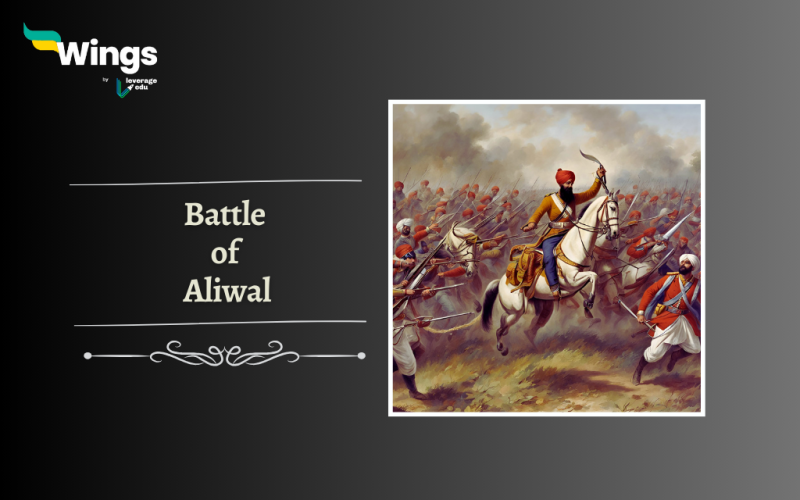The Battle of Aliwal was fought between the East India Company and the Sikh Khalsa army. It took place on 28th January 1846 on the banks of river Sutlej in Aliwal of Punjab. The British forces won the battle which later led to eventual control of the British forces over the princely state of Punjab. In this blog, let us together get to know more about the Battle of Aliwal with its background, event of the day and its outcome.
Table of Contents [show]
| Battle of Aliwal Overview | |
| Battle Took Place On | 28th January, 1846 |
| Place | Aliwal, Punjab |
| Fought Between | Sikh Khalsa Army Vs East India Company |
| Won By | East India Company |
Background of the Battle of Aliwal
After Maharaja Ranjit Singh established the Sikh Empire in the early 19th century, he built a powerful Khalsa army that was renowned for its courageous and skilled soldiers. On the other side, the British East India Company were also strengthening their army and growing in numbers.
- However, following Ranjit Singh’s death in 1839, the Sikh Empire began to weaken which led to internal conflicts and the empire also saw a decline in control over the Khalsa army.
- Taking advantage of this deterioration of the Sikh Empire, the British East India Company strengthened its forces along the Punjab borders.
- The company aimed to expand its territorial influence by subduing a significant power in one of the central and powerful regions of India.
- They formed strategies to take control of the region and add it to their territorial holdings.
Also Read – Battle Of Diu: Background, Event, Outcome & More
Event of the Battle
The events of the battle started when the First Anglo-Sikh War happened in 1845, the Khalsa army on 11th December crossed the Sutlej River and attacked British territories.
- This conflict included battles at Ferozeshah Mudki in December of that year along with the battle at Aliwal in January of the following year, resulting in the Sikhs being compelled to withdraw by the British army.
- Despite this setback, the Khalsa army re-engaged in the war by crossing the river once more.
- They dispatched a unit led by Ranjodh Singh Majithia to launch an attack on the British stronghold at Ludhiana Fort and disrupt their communication and supply routes.
- In retaliation, the British dispatched troops led by General Sir Harry Smith to fight against the Khalsa forces. The ensuing battle took place at Aliwal on 28 January 1846.
Outcome of the Battle
- The British forces comprised 12,000 soldiers, inclusive of Indian troops from the Bengal army. They were also equipped with approximately 32 guns.
- On the other hand, the Khalsa army comprised roughly 20,000 soldiers and possessed around 70 guns.
- The battle was fiercely contested, with both sides valiantly fighting for victory.
- However, even being outnumbered, it resulted in a triumph for the British, and their skilled leader General Smith was honoured with a baronetcy for his success.
- Following this battle, the Khalsa forces were also defeated at the Battle of Sobraon held on 10th February 1846.
- Subsequently, the Treaty of Lahore was concluded in March 1846, which was also the conclusion of the First Anglo-Sikh War.
FAQs
The First Sikh War (1845-46) saw a British-Indian force engage the Sikh army of the Punjab, known as the Khalsa (literally ‘the pure’), in a battle on 28 January 1846. The outcome was a clear victory for the British, and some consider it to be a ‘near perfect battle’.
The Battle of Sobraon took place on February 10, 1846. It was the fourth, final, and conclusive battle of the First Sikh War (1845–46). The Sikhs had established their position on the eastern bank of the Sutlej River, which was under British control, and they had secured their withdrawal with a bridge made of boats.
In 1845-46, there was a war between the British and the formidable Sikh Empire in the Punjab. The conflict concluded with the British gaining partial authority over the Sikh territories after a series of fiercely contested battles.
Relevant Blogs
This was all about the Battle of Aliwal. For more content related to the different states of India, visit our articles like this, you can get Study notes on the Modern History of India here. Also, you can visit our general knowledge page on Indian History!
 One app for all your study abroad needs
One app for all your study abroad needs















 45,000+ students trusted us with their dreams. Take the first step today!
45,000+ students trusted us with their dreams. Take the first step today!
